Purchas D. Handbook of Filter Media
Подождите немного. Документ загружается.


54 Handbook of Filter Media
Table 2.6 Fibres for high temperature dust filtration
Fibre Acronym or Max.
example temperature (~C)
Continuous Surge
Resistance to
attack by oxidizing
Agents Acids Alkalis Abrasion
Cotton
Wool
Polyamide Nylon
Polypropylene PP
Polyacrylonitrile Dralon
Polyester Dacron
Polyphenylene Ryton
sulphide
Polyaramid Nomex
Polyimide P84
Polytetra- Teflon
fluoroethylene
Glass
Incone1601 Bekinox
Ceramic, metal Nextel
oxides
80 95
95 110
95 120
95 105
130 140
150 180
190 230
200 240
240 260
260 280
280 300
550 600
760 1200
Fair Poor Good Good
Fair Good Poor Good
Fair Poor Good Fair
Good Excellent Excellent Good
Excellent Excellent Fair Fair
Good Fair Poor Excellent
Good Excellent Excellent Good
Poor Poor Good Excellent
Excellent Fair Good Good
Excellent Excellent Excellent Fair
Excellent Poor poor poor
Excellent Excellent excellent good
Excellent Good good good
Table 2.7 Effect of type of yarn on filter fabric performance (1 = best)
Performance characteristic
Order of preference
1 2 3
Maximum filtrate clarity Staple Multifil Monofil
Minimum resistance to flow Monofil Multifil Staple
Minimum moisture in cake Monofil Multifil Staple
Easiest cake discharge Monofil Multifil Staple
Maximum fabric life Staple Multifil Monofil
Least tendency to blind Monofil Multifil Staple
Table 2.8 Effect of yarn structure on filter fabric performance (1 = best)
Performance characteristic
Structure parameter a
Yarn diameter Twists/cm Fibres/yarn
1 2 3 1 2 3 1 2 3
Maximum filtrate clarity L M S Lo M H H M Lo
Minimum resistance to flow S M L H M Lo Lo M H
Minimum moisture in cake S M L H M Lo Lo M H
Easiest cake discharge S M L H M Lo H M Lo
Maximum fabric life L M S M Lo H M H Lo
Least tendency to blind S M L H M Lo Lo M H
a L- large, M = medium, S - small. Lo - low, H - high.
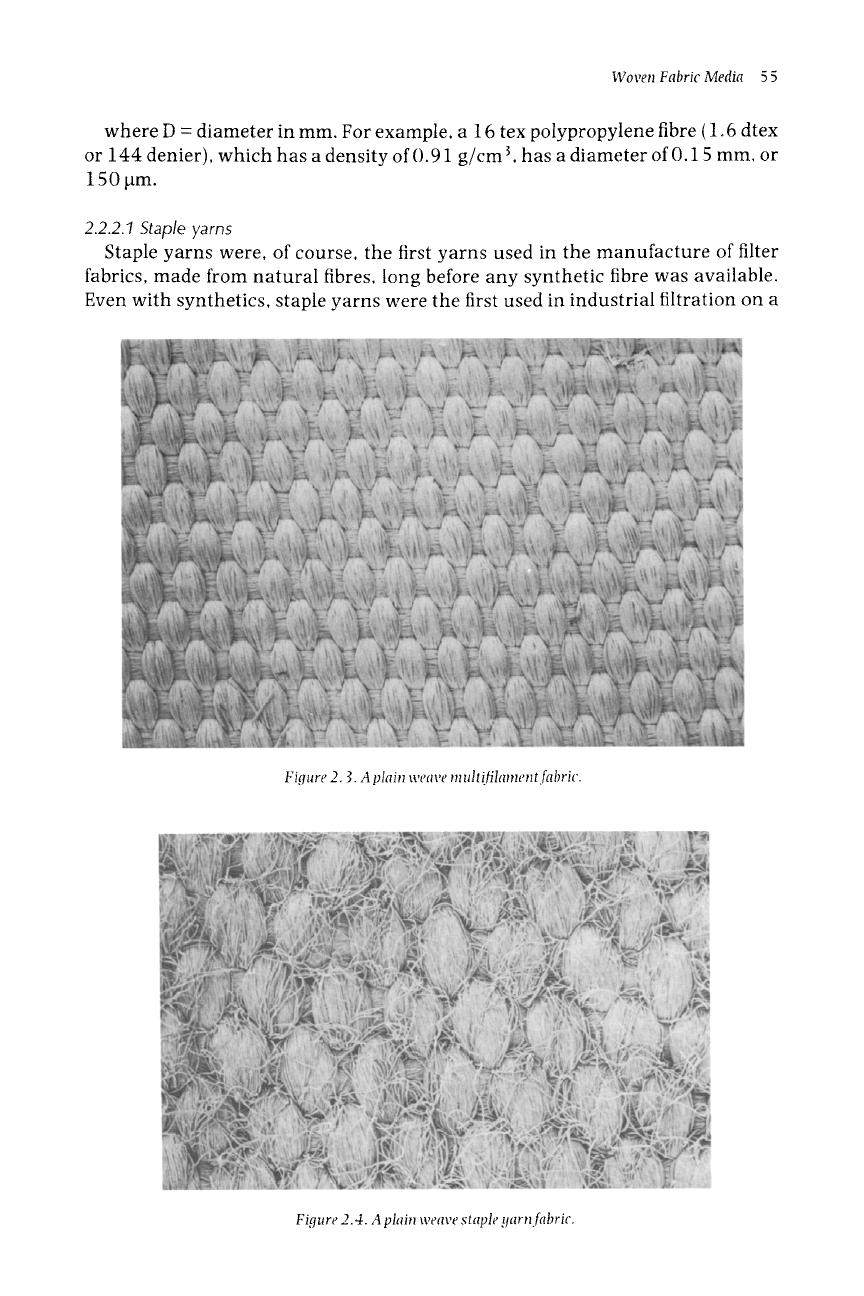
Woven Fabric Media 5 5
where D = diameter in mm. For example, a 16 tex polypropylene fibre (1.6 dtex
or 144 denier), which has a density of 0.91 g/cm 3, has a diameter of 0.15 mm, or
150 pro.
2.2.2.1 Staple yarns
Staple yarns were, of course, the first yarns used in the manufacture of filter
fabrics, made from natural fibres, long before any
synthetic
fibre was available.
Even with synthetics, staple yarns were the first used in industrial filtration on a
Figure 2.3. A plain weave multi filamentfabric.
Figure 2.4. A plain weave staple yarn fabric.

56 Handbook of Filter Media
large scale, since they made possible the production of the heavy-duty, durable
fabrics needed for traditional filter presses and leaf filters.
Natural fibres, supplied in bulk, must first be cleaned to remove foreign matter
(and grease, in the case of wool). Natural fibres, after cleaning, and artificial
fibres, after cutting to the appropriate length, are carded by means of an array of
spikes, which separates the individual fibres, and lays them parallel, as a thin
sheet of uniform thickness. This sheet is then drawn together to produce a thick,
continuous and untwisted sliver (if the sliver is given a loose twist, it becomes
roving). Before the carding, the fibres may be mixed by blending in different lots of
material, usually to ensure the production of a uniform yarn.
An additional process, called combing, may follow carding. This process
removes short fibres, and produces a sliver made up of long fibres, lying parallel,
which is smoother and more lustrous than uncombed sliver. At any given yarn
diameter, a combed yarn is stronger than an uncombed one.
Slivers (or roving) are then processed in spinning machines, which stretch the
strands and twist them to the required degree, both to hold the fibres together,
and to give the necessary strength to the yarn. The direction of twist can result
either in S-twist or Z-twist, with a slope increasing with the tightness of the twist;
the opposite direction of twist is then normally used for converting the single
yarn into a two- (or more) ply yarn. Within reason, the greater the degree of twist
the stronger the yarn - but also the less useful it is in a filter fabric, when flow
through the yarn is required.
A major difference between staple yarns and other types is the 'hairier' finish.
This can readily be seen by comparing Figures 2.3 and 2.4. The impact of this
difference is the greater difficulty in removing a filter cake from a fabric made
with staple yarn than is the case with fabrics made up from silk or polymeric
filaments.
The spinning processes used to make staple yarns are developed either from
the spinning of cotton (with relatively short fibres, in the region of 40 or 50 mm),
or the spinning of wool (with considerably longer fibres, perhaps 2-3 times the
length of cotton, and much more crimped). Synthetic fibres are cut from the
extruded filaments of polymer in lengths to suit whichever of these two spinning
systems is to be used.
As a general guide, yarns from woollen spinning systems are bulkier than
those from cotton systems, while the fibres within wool-spun yarns can move
more easily within the yarn assembly. It is thus claimed that wool-spun yarns
are better for filtration than either cotton-spun staple yarns or multifilament
yarns, by permitting a higher throughput, and by being less prone to blinding.
2.2.2.2 Monofilament yarns
It is perhaps strange to call a monofilament a yarn in view of the latter's
normal multifibrous connotation. Nevertheless, monofilaments are used in
significant quantity in filtration fabrics, either as the only yarn or as a warp yarn
with the weft of some different (and usually bulkier) yarn. A large proportion of
fabrics made only with monofilament are better called meshes- and as such are
covered in Chapter 6.
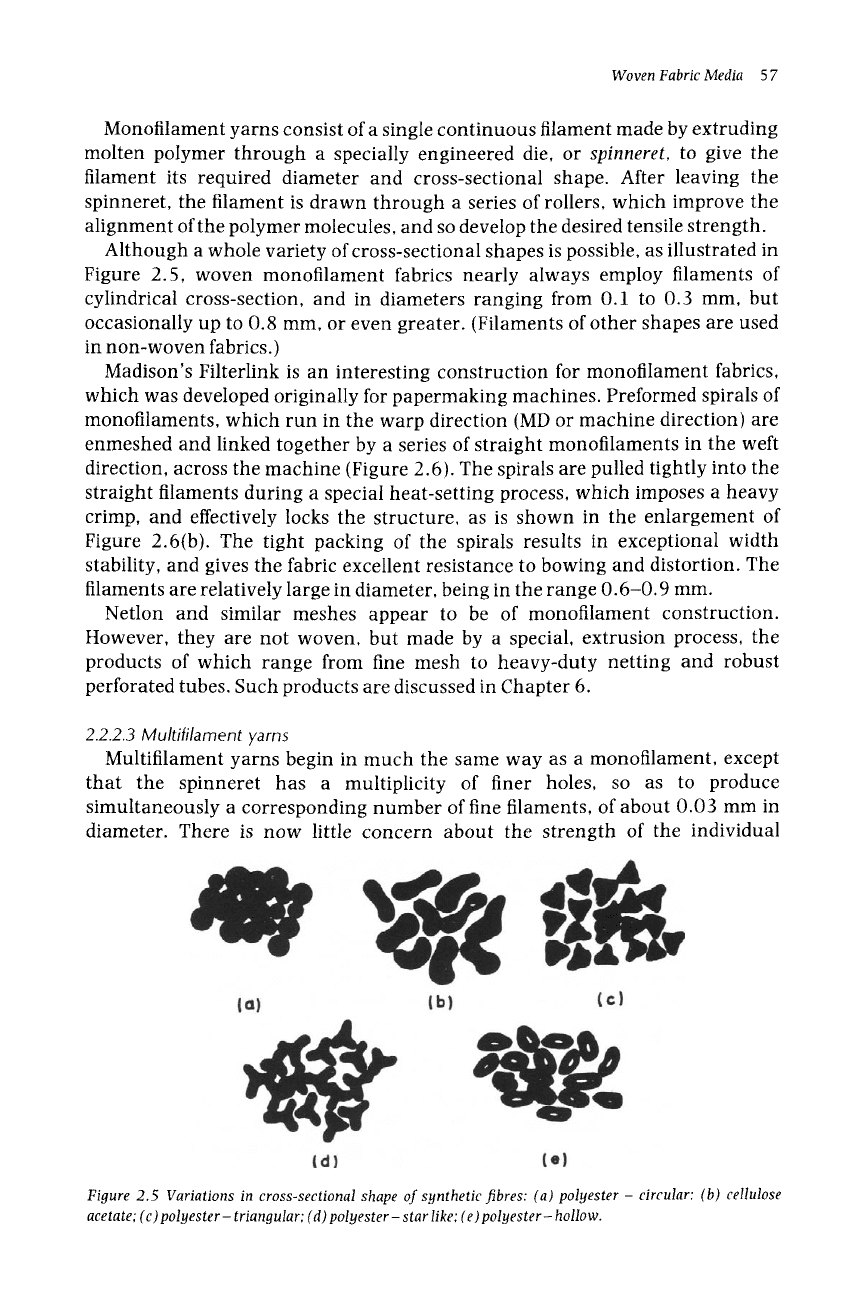
Woven Fabric Media 5 7
Monofilament yarns consist of a single continuous filament made by extruding
molten polymer through a specially engineered die, or
spinneret,
to give the
filament its required diameter and cross-sectional shape. After leaving the
spinneret, the filament is drawn through a series of rollers, which improve the
alignment of the polymer molecules, and so develop the desired tensile strength.
Although a whole variety of cross-sectional shapes is possible, as illustrated in
Figure 2.5, woven monofilament fabrics nearly always employ filaments of
cylindrical cross-section, and in diameters ranging from 0.1 to 0.3 mm, but
occasionally up to 0.8 mm, or even greater. (Filaments of other shapes are used
in non-woven fabrics.)
Madison's Filterlink is an interesting construction for monofilament fabrics,
which was developed originally for papermaking machines. Preformed spirals of
monofilaments, which run in the warp direction (MD or machine direction) are
enmeshed and linked together by a series of straight monofi|aments in the weft
direction, across the machine (Figure 2.6). The spirals are pulled tightly into the
straight filaments during a special heat-setting process, which imposes a heavy
crimp, and effectively locks the structure, as is shown in the enlargement of
Figure 2.6(b). The tight packing of the spirals results in exceptional width
stability, and gives the fabric excellent resistance to bowing and distortion. The
filaments are relatively large in diameter, being in the range 0.6-0.9 mm.
Netlon and similar meshes appear to be of monofilament construction.
However, they are not woven, but made by a special, extrusion process, the
products of which range from fine mesh to heavy-duty netting and robust
perforated tubes. Such products are discussed in Chapter 6.
2.2.2.3 Multifilament yarns
Multifilament yarns begin in much the same way as a monofilament, except
that the spinneret has a multiplicity of finer holes, so as to produce
simultaneously a corresponding number of fine filaments, of about 0.03 mm in
diameter. There is now little concern about the strength of the individual
Figure 2.5 Variations in cross-sectional shape of synthetic fibres: (a) polyester- circular: (b) cellulose
acetate; (c) polyester-triangular; (d) polyester- star like: (e) polyester-hollow.
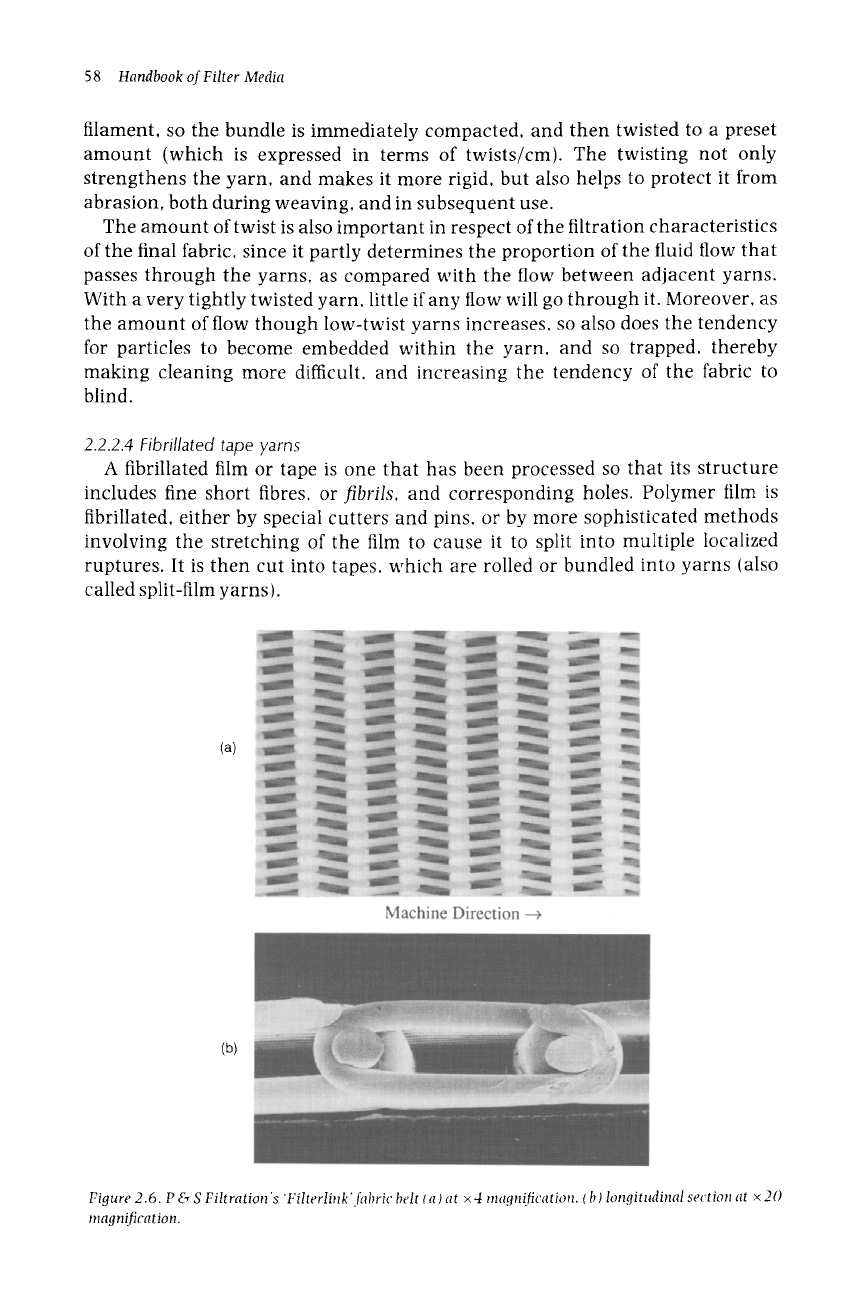
58
Handbook of Filter Media
filament, so the bundle is immediately compacted, and then twisted to a preset
amount (which is expressed in terms of twists/cm). The twisting not only
strengthens the yarn, and makes it more rigid, but also helps to protect it from
abrasion, both during weaving, and in subsequent use.
The amount of twist is also important in respect of the filtration characteristics
of the final fabric, since it partly determines the proportion of the fluid flow that
passes through the yarns, as compared with the flow between adjacent yarns.
With a very tightly twisted yarn, little if any flow will go through it. Moreover, as
the amount of flow though low-twist yarns increases, so also does the tendency
for particles to become embedded within the yarn, and so trapped, thereby
making cleaning more difficult, and increasing the tendency of the fabric to
blind.
2.2.2.4 Fibrillated tape yarns
A fibrillated film or tape is one that has been processed so that its structure
includes fine short fibres, or
fibrils,
and corresponding holes, Polymer film is
fibrillated, either by special cutters and pins, or by more
sophisticated
methods
involving the stretching of the film to cause it to split into multiple localized
ruptures. It is then cut into tapes, which are rolled or bundled into yarns (also
called split-film yarns).
(a)
(b)
Figure
2.6.
P ~, S Filtration's 'Filterlink" fal~ric belt ( a ) at • 4 magnification. (b) longitudinal section at • 20
magnification.

Woven Fabric Media 5 9
These yarns are normally made from highly orientated polypropylene, since
its non-polar nature and the low intermolecular forces between the long linear
polymer chains lend themselves well to the fibrillation process. This involves
embossing the film with a pattern by pressurized contact with rollers, which
have surfaces that have been photo-etched (as in gravure printing). The
embossed film is then heated and stretched in one or more directions, thus
causing the indentations to rupture. Variations are possible in film thickness,
embossed pattern, and stretching process, which enable the manufacture of a
wide variety of products, either as yarns, or in sheet form, and as netting.
Fibrillated yarns are widely used in the textile industry, but mainly to make
heavy-duty industrial fabrics, for applications such as bulk container bags,
carpet backing, geotextiles, and agricultural uses. They have only a limited use
in filtration, mainly to produce coarse open fabrics used as support or drainage
cloths beneath finer grades of filter fabric. An example of a support cloth is shown
in Figure 2.7.
Yarns of this kind are available in many different grades, the product range of
the Fibrilon yarns, produced by Synthetic Industries Inc, extending from 2 50 up
to ]0 O00 denier or more. An elegant illustration of their delicate structure is
shown in Figure 2.2.
2.2.2.5 Mixed yarns
The above discussion of types of yarn has assumed that the yarn will be used as
both warp and weft in any fabric woven from them. However, instead of using
identical yarns, a combination of different yarns can be very beneficial.
One common combination is the use of multifilament yarn for the warp, with
staple yarn for the weft, an example of which is shown in Figure 2.8. The higher
tensile properties of the warp give strength to the fabric, while its filament
Figure 2.7. A support of backing cloth made from fibrillated yarn in mock-leno weave.

60
Handbook of Filter Media
structure
gives a reasonably smooth surface. The contribution from
the
weft is
bulk, which improves the filtration efficiency and the durability of the fabric.
A different combination is to use a monofilament warp, which aids cake
discharge, with a multifilament weft, with its better collection efficiency.
Alternatively, the main weft yarn may be combined with a secondary one, to act
as a filler, thereby increasing the bulk of the fabric.
2.3 Woven Fabric Media
The basic material of a woven fabric (filament or fibre) and the way that this
material is formed into a yarn are major parameters in the choice of a fabric as a
filter medium. The third such parameter is the way in which the yarns are laced
together, i.e. the type of
weave,
together with any
finishing
process applied to the
fabric. These are now considered, together with the properties of the resultant
fabric.
2.3.1 Types of woven fabric
The variety of available woven fabrics is virtually unlimited even if only the
materials from which the filaments or yarns, and the complexity of the yarn are
considered. To these must then be added the structure of the woven fabric itself:
the way in which the yarns are woven together, and the finishing process (if any)
applied to the fabric after weaving.
In common with all industrial textiles, filter fabrics have to meet quite rigid
specifications as to width, weight per unit area, weave and yarn structure,
strength and elongation, thickness and chemical properties. Flexibility may be
an important requirement, and the necessary porosity certainly is. There are, of
Figure 2.8. A mixed yarn reverse-satin weave fabric, with multifilament warp and staple weft.

Woven Fabric Media 61
course, many other properties of fabrics that are of no concern to their use as
filter media.
Woven fabrics are made up from yarns that are interlaced in a particular and
regular order called a
weave.
The component yarns, warp and weft, need not be
parallel to each other nor cross at right angles, but this is the case in most fabrics,
and certainly it is so in filter media. The key features of a woven fabric come from
the geometrical regularity of its components, and because these components are
held in place, not by any rigid bonding, but by friction at their points of contact.
2.3.1.1 Types o[
weave
The binding system, or weave, is the basic factor that determines the character
of the woven fabric. There are three main types of weave:
9 plain,
9 twill, and
9 satin,
that are used in industrial textiles, as illustrated in Figure 2.9, although there
are many other more complex systems, some deriving from hand manipulation,
and others from mechanical changes in the loom. Examples of such complex
patterns include the creation of a pile, or the formation of a gauze - the latter
having some importance in filtration fabrics (as a
leno
weave).
The differences among the weaves depend upon the pattern formed as the weft
yarns are woven over or under the longitudinal warp yarns. In the diagrams of
Figure 2.9, the warps are numbered 1, 2, 3, etc., and the wefts are identified as a,
b, c, etc. A white square, such as a2, corresponds to the passage of the weft over
the warp.
In
plain
weave, the weft yarn passes over and then under each succeeding
warp yarn across the loom, as shown in Figure 2.3. The return weft then passes
the opposite way, under then over succeeding warps, such that each weft is held
securely in place by the interlocking of the warp yarns. If necessary, each
2.9. The three basic weaves generally used for filter cloths.
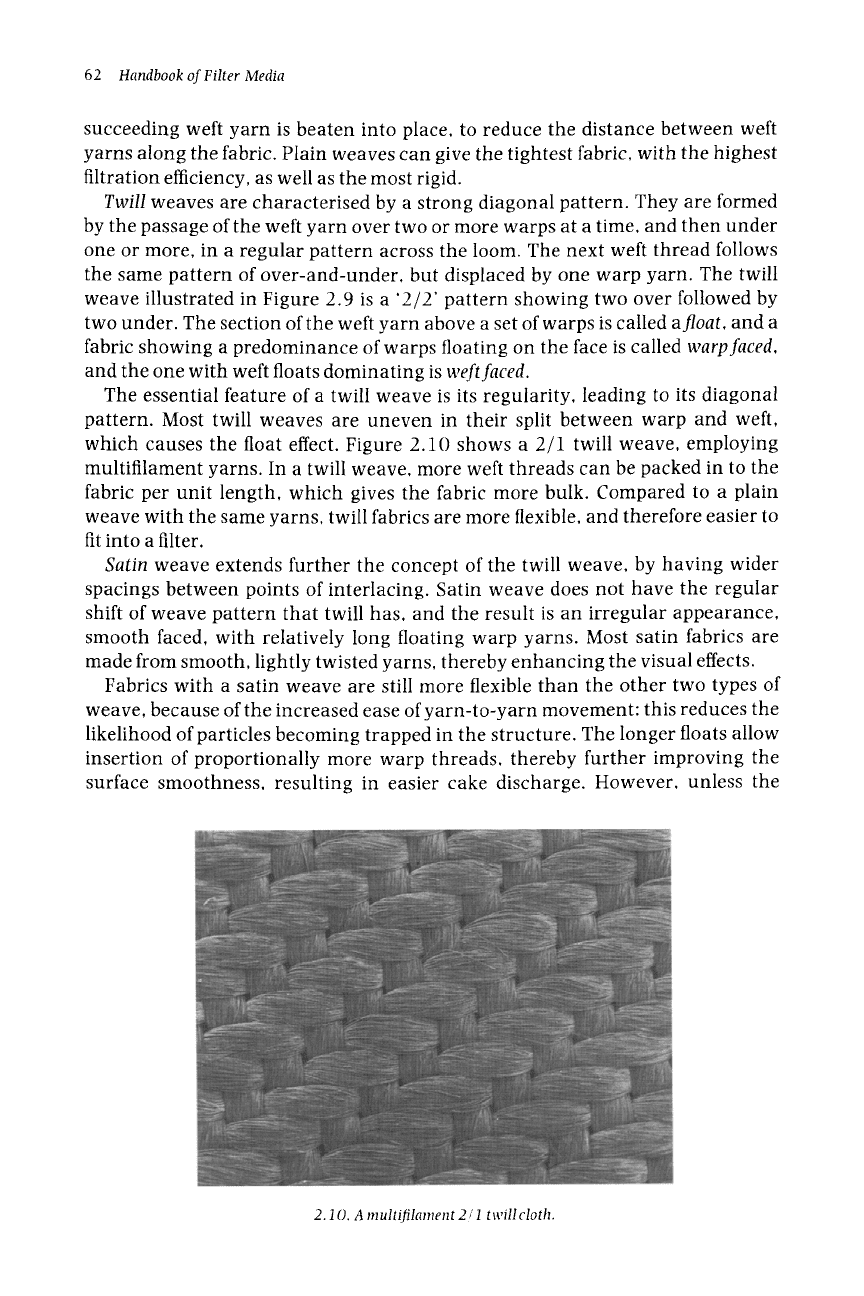
62
Handbook of Filter Media
succeeding weft yarn is beaten into place, to reduce the distance between weft
yarns along the fabric. Plain weaves can give the tightest fabric, with the highest
filtration efficiency, as well as the most rigid.
Twill
weaves are characterised by a strong diagonal pattern. They are formed
by the passage of the weft yarn over two or more warps at a time, and then under
one or more, in a regular pattern across the loom. The next weft thread follows
the same pattern of over-and-under, but displaced by one warp yarn. The twill
weave illustrated in Figure 2.9 is a '2/2' pattern showing two over followed by
two under. The section of the weft yarn above a set of warps is called
afloat,
and a
fabric showing a predominance of warps floating on the face is called
warp faced,
and the one with weft floats dominating is
weft faced.
The essential feature of a twill weave is its regularity, leading to its diagonal
pattern. Most twill weaves are uneven in their split between warp and weft,
which causes the float effect. Figure 2.10 shows a 2/1 twill weave, employing
multifilament yarns. In a twill weave, more weft threads can be packed in to the
fabric per unit length, which gives the fabric more bulk. Compared to a plain
weave with the same yarns, twill fabrics are more flexible, and therefore easier to
fit into a filter.
Satin
weave extends further the concept of the twill weave, by having wider
spacings between points of interlacing. Satin weave does not have the regular
shift of weave pattern that twill has, and the result is an irregular appearance,
smooth faced, with relatively long floating warp yarns. Most satin fabrics are
made from smooth, lightly twisted yarns, thereby enhancing the visual effects.
Fabrics with a satin weave are still more flexible than the other two types of
weave, because of the increased ease of yarn-to-yarn movement: this reduces the
likelihood of particles becoming trapped in the structure. The longer floats allow
insertion of proportionally more warp threads, thereby further improving the
surface smoothness, resulting in easier cake discharge. However, unless the
2. lO. A multifilament 2/1 twill cloth.
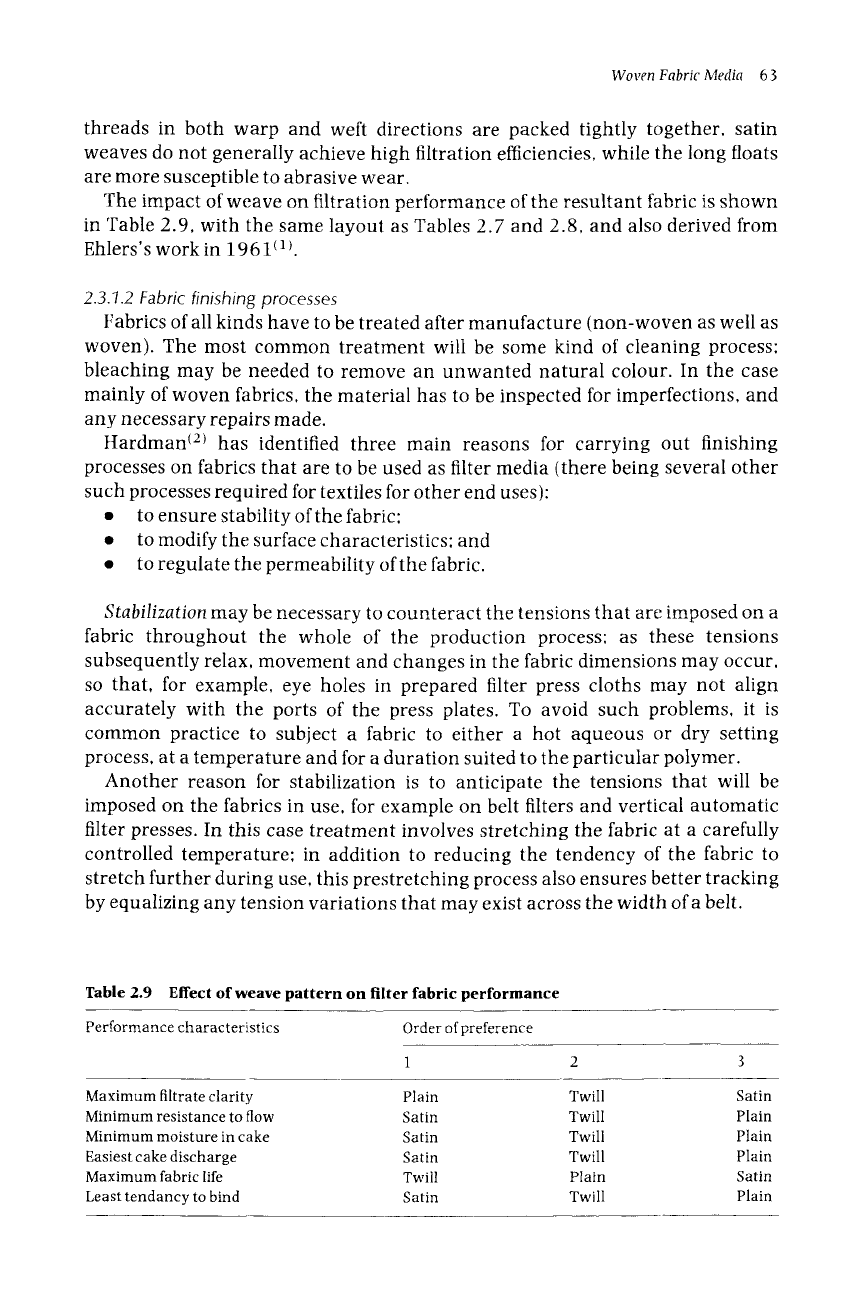
Woven Fabric Media 6 3
threads in both warp and weft directions are packed tightly together, satin
weaves do not generally achieve high filtration efficiencies, while the long floats
are more susceptible to abrasive wear.
The impact of weave on filtration performance of the resultant fabric is shown
in Table 2.9, with the same layout as Tables 2.7 and 2.8, and also derived from
Ehlers's work in 19 61( 1 t.
2.3.1.2
Fabric finishing processes
Fabrics of all kinds have to be treated after manufacture (non-woven as well as
woven). The most common treatment will be some kind of cleaning process:
bleaching may be needed to remove an unwanted natural colour. In the case
mainly of woven fabrics, the material has to be inspected for imperfections, and
any necessary repairs made.
Hardman (2) has identified three main reasons for carrying out finishing
processes on fabrics that are to be used as filter media (there being several other
such processes required for textiles for other end uses):
9 to ensure stability of the fabric:
9 to modifythe surface characteristics: and
9 to regulate the permeability of the fabric.
Stabilization
may be necessary to counteract the tensions that are imposed on a
fabric throughout the whole of the production process: as these tensions
subsequently relax, movement and changes in the fabric dimensions may occur,
so that, for example, eye holes in prepared filter press cloths may not align
accurately with the ports of the press plates. To avoid such problems, it is
common practice to subject a fabric to either a hot aqueous or dry setting
process, at a temperature and for a duration suited to the particular polymer.
Another reason for stabilization is to anticipate the tensions that will be
imposed on the fabrics in use, for example on belt filters and vertical automatic
filter presses. In this case treatment involves stretching the fabric at a carefully
controlled temperature; in addition to reducing the tendency of the fabric to
stretch further during use, this prestretching process also ensures better tracking
by equalizing any tension variations that may exist across the width of a belt.
Table 2.9 Effect of weave pattern on filter fabric performance
Performance characteristics
Order of preference
1 2 3
Maximum filtrate clarity Plain Twill Satin
Minimum resistance to flow Satin Twill Plain
Minimum moisture in cake Satin Twill Plain
Easiest cake discharge Satin Twill Plain
Maximum fabric life Twill Plain Satin
Least tendancy to bind Satin Twill Plain
